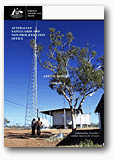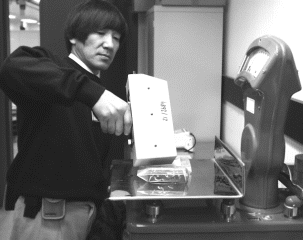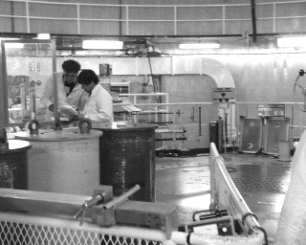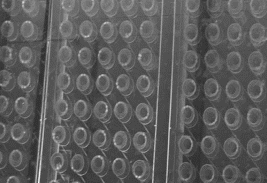


Annual Report 1998-99 |
 |
PROGRAM ACTIVITIES
ASNO’s activities in 1998–99 are described and evaluated in the following sections.
Activities are described in relation to particular tasks, and grouped according to the output to which they relate (see summary of outcomes and outputs).
OUTPUT A
Operation of Australia’s national system of accounting for, and control of, nuclear material and items subject to IAEA safeguards, including promotion and regulation, within Australia, of effective measures for the physical protection of nuclear facilities and material.
Milestone A1
A1.1 The provisions of the Nuclear Non-Proliferation (Safeguards) Act 1987 administered effectively.
A1.2 The continued adequacy of the Act’s provisions reviewed and evaluated.
A1.3 Under the Act’s Permit System, nuclear items in Australia - including those subject to bilateral safeguards agreements - controlled and accounted for effectively.
Activities
Permits and authorities
During the year two new permits or authorities under the Safeguards Act were issued, two expired and none were revoked.
Table 3. Status of Safeguards Permits and Authorities in Australia.
| Permit or Authority to |
|
|
|
| possess nuclear material | 0 | 0 | 30 |
| possess associated items | 1 | 1 | 21 |
| transport nuclear material | 0 | 0 | 21 |
| transport associated items | 0 | 0 | 0 |
| communicate information contained in associated technology | 1 | 1 | 17 |
| Total | 2 | 2 | 89 |
An Australian company, Silex Systems Pty Ltd, is researching a novel method of separating uranium isotopes using laser techniques. The company has entered into an agreement with the United States Enrichment Corporation (USEC) to explore the commercial potential of this technology. In the first phase, Silex is demonstrating the technology to USEC specialists. If this, and further development work are successful, the technology may be commercialised in the United States - this aspect is discussed further under Milestone B2.
ASNO is paying close attention to progress, since the Silex technology will have to be classified as ‘associated technology’ and ‘associated equipment’ under the Safeguards Act if it proves practicable for the enrichment of nuclear material, or if it is considered that details of the technology could be useful for others working in the enrichment field. ASNO’s objective here is to ensure that nuclear technology remains in exclusively peaceful use and does not contribute to any proliferation efforts. Classification as ‘associated technology’ will have the result of restricting access to the technology to authorised persons. ASNO is also concerned to ensure that all IAEA reporting requirements with respect to nuclear-related R&D are met. In anticipation that the Silex process may become ‘associated technology’, ASNO has already put in place appropriate measures to ensure against unauthorised access.
Data reported pursuant to the Safeguards Act
As required by sub-section 51(2) of the Safeguards Act, details of nuclear material and associated items of Australian origin, and nuclear material and associated items within Australia, regardless of origin, are set out in Annexes to this Report as follows:
Annex A: Nuclear Material within Australia at 30 June 1999
Annex B: Associated Items within Australia at 30 June 1999
Annex C: Australian Obligated Nuclear Material Overseas:
(i) Locations and Quantities of AONM at 31 December 1998
(ii) Transfers of AONM during 1998.
As in previous years, no associated items of Australian origin are located overseas.
ASNO also provides the Australian National Audit Office with a statement each year of holdings of nuclear items by ANSTO.
Performance Assessment
Administration of the Permit System was carried out in a timely manner, with all changes published in the Commonwealth of Australia Gazette as required by the Safeguards Act. All nuclear material and nuclear items within Australia were satisfactorily accounted for as at 30 June 1999.
Milestone A2
IAEA safeguards implemented satisfactorily in Australia.
Activities
Australia’s State System of Accounting for and Control of Nuclear Material (SSAC) is operated by ASNO in accordance with Australia’s safeguards agreement with the IAEA. ASNO reports to the IAEA on the disposition of nuclear material in Australia and facilitates inspections carried out by the IAEA at Australian facilities.
Reports on the disposition of nuclear material
Each month an ASNO officer carries out an audit of the inventory of nuclear material at the ANSTO site at Lucas Heights (near Sydney), which is the principal location of safeguardable nuclear material in Australia. Changes during the month in that inventory (as well as any changes elsewhere in Australia) are reported by ASNO to IAEA headquarters in Vienna. Accounting reports are also given to the IAEA by ASNO following the IAEA inspections described below.
Details of Australian Accounting Reports to the IAEA during the year are at Annex D.
IAEA inspections in Australia
As in other countries covered by IAEA safeguards, the Agency carries out routine inspections of Australian nuclear facilities. The aim of these inspections is to verify that nuclear material inventories are as declared by the operator and the SSAC. Each inspection deals with what is known as a Material Balance Area (MBA), of which Australia has five as listed in Table 4.
Table 4. Material Balance Areas in Australia
| Location | MBA | Facility |
| ANSTO | AS-A | HIFAR reactor (2) |
| ANSTO | AS-B | Moata reactor |
| ANSTO | AS-C | Research and Development Laboratories |
| ANSTO | AS-D | Vault Storage |
| Elsewhere | AS-E | Other locations in Australia |
(2) In February 1995 the ANSTO Board decided to cease operation of Moata, and the reactor was defuelled in May 1995.
IAEA inspectors visited Australia on 12 occasions during 1998–99 to carry out routine inspections (see Annex D for details). Because of a temporary increase in ANSTO’s inventory of fresh fuel, IAEA inspections took place on a monthly basis and this arrangement continued until the stock of fresh fuel fell below 25 kilograms of U-235 (i.e. one ‘Significant Quantity’) in May 1999.
ASNO, as the national safeguards authority, acts as the intermediary between the IAEA and the facility operator on all safeguards matters. An ASNO officer accompanies IAEA inspectors during inspections in Australia. The officer ensures the inspectors may carry out their duties, so that Australia meets its obligations, and mediates on any issues arising between the IAEA and the facility operator. In particular, ASNO assists in the resolution of any inconsistencies discovered during inspections, thus simplifying the IAEA inspectors’ task.
A major focus of IAEA inspection activity is the identification and evaluation of ‘material unaccounted for’ (MUF), that is, the difference between the records maintained by the operator (the ending book inventory) and the physical inventory verified by the IAEA. Since MUF is the difference between two measured quantities, it may be equal to zero, or it may be either a positive or negative value. If MUF is positive it does not necessarily indicate that material has been lost, nor does a negative figure mean that material has somehow been created. In the normal course, some measurement differences are expected. This is illustrated by the small MUF of enriched uranium declared for MBA AS-C (R&D laboratories) during the year. The Physical Inventory for this MBA was 106.88 grams of uranium element less than the Book Inventory, but was 79.27 grams of U-235 isotope more.
The IAEA reports all conclusions drawn from its routine safeguards inspections in Australia, including comments on any MUF, in the statements provided pursuant to Article 91(b) of Australia’s NPT safeguards agreement. A summary of Statements provided during the year for Material Balance Areas AS-A, B, C and D and an explanatory note on MBA AS-E are provided at Annex E of this Report.
 |
|
single-channel analyser - Photograph courtesy of ANSTO |
Declaration of Safeguards Inspectors
Under section 57 of the Safeguards Act, the Minister may declare a person to be an Inspector for the purposes of the Act. In practice, this applies only to officers of ASNO. The role of an Inspector is to ensure compliance with provisions of the Safeguards Act and to assist IAEA inspectors in the conduct of Agency inspections in Australia. No new national inspectors were declared in 1998–99.
The Minister may declare a person designated by the IAEA as an ‘Agency Inspector’ for the purpose of the Safeguards Act. In practice, all IAEA staff designated to Australia are declared under the Safeguards Act - there were 12 new designations during 1998–99. There are currently 163 IAEA staff declared as Agency Inspectors pursuant to the Act.
Since 1990, inspector appointment and declaration powers have been delegated by the Minister to the Director of Safeguards.
Performance Assessment
All routine IAEA inspections proceeded smoothly and all apparent discrepancies were resolved.
IAEA statements during 1998–99 confirm that all of Australia’s IAEA safeguards obligations were discharged satisfactorily and, specifically, that Australia’s records had been maintained in accordance with prescribed practice. ASNO’s reporting fully satisfies IAEA requirements.
The IAEA has never found cause to comment adversely on Australia’s accounting for and control of nuclear material - a fact reflected in Article 91(b) statements over the years.
 |
|
IAEA inspector. The top face of the reactor can be seen at floor level to the right of the photograph - Photograph courtesy of ANSTO |
Milestone A3
A3.1 Appropriate physical protection measures for nuclear material in Australia reviewed; sites holding nuclear items audited to ensure that prescribed physical protection measures have been implemented effectively.
A3.2 Sites holding nuclear items audited to ensure that prescribed physical protection measures have been implemented effectively.
Activities
Physical Protection within Australia
ASNO is responsible for prescribing the levels of physical protection or security to be applied to nuclear items subject to the Safeguards Act. During the year, inspections were carried out of the physical protection measures applied at ANSTO. Inspections were also carried out of the physical protection measures applied at, and in connection with, the two uranium mining operations in South Australia and the Northern Territory. In addition, regular inspections were made of the arrangements put in place for the protection of potentially sensitive information relating to the Silex laser enrichment R&D project at Lucas Heights.
 |
|
at ANSTO - Photograph courtesy of ANSTO |
Performance Assessment
Physical protection requirements prescribed by ASNO are consistent with internationally agreed standards.
Inspections at ANSTO had satisfactory outcomes: physical protection was judged satisfactory. Physical protection at the uranium mines was also assessed as satisfactory.